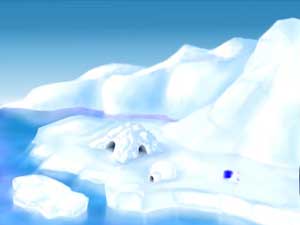Study ice cores to explore climate change rules
Small amounts of salt and dust kept in the Antarctic ice sheets over the past 740,000 years have uncovered new signs of Earth's climate changes.
The results were published in Nature by a research group.
 Antarctic iceberg. (Artwork from foreign website) They took an ice core with a length of 3km from Peak C, the peak located on the Eastern South Plains. This is a result of climate research continuously from a farthest point in the past, due to research from ice cores so far.
Antarctic iceberg. (Artwork from foreign website) They took an ice core with a length of 3km from Peak C, the peak located on the Eastern South Plains. This is a result of climate research continuously from a farthest point in the past, due to research from ice cores so far.
Since reporting in 2004 that the Earth has undergone eight cycles of climate change (each with a glacial period and a warm climate), the research team analyzed the impurities. The chemical in the ice core sheds light on how the earth's climate changes over the past 740,000 years.
By measuring the change in salt content in ice cores, the team can estimate how far the Antarctic ice sheets expand each time the Antarctica cools.
Salt appears in ice from seawater on the face of newly formed ice sheets (frozen sea water). White ice sheets cover the sea, making the Earth reflect more sunlight.
Small dust particles are blown by the wind from the surrounding continents. Most of them were found in the ice core from the ice age. From this observation, the team concludes that the nearest continent, south of South America, is more dry and windy. This dust can bring nutrients to the ocean, helping bacteria to absorb CO2 from the atmosphere. From the different effects of salt and dust, the researchers believe that every time the Earth warms after going through an ice age, the South American region will change first, then the expansion of ice sheets on the sea.
"Our research shows that, over the past 740,000 years, every time the ice age gives way to a period," said research leader Dr. Eric Wolff at the Antarctic Institute of England. warmer, similar changes take place in the same sequence. We conclude that the Earth follows the rules when climate changes and if we can understand this rule we can improve climate models and make more accurate predictions in the future. '.
Ice core drilling at Peak C is part of Europe's Antarctic Ice Core Drilling Project (EPICA). The team at Peak C suffered heat stress in the summer below 40ºC in the remote drilling area thousands of kilometers away from the nearest research station. Ice drill work was completed in December 2004 after drilling down to 3260m of tape.
- The 6th China discovered the Arctic
- This is how Dubai copes with climate change
- What is Climate Change?
- Marching for climate change around the world
- The terrifying change of the Earth due to climate change
- Monitoring climate change with new methods
- SimCLIM helps build climate change scenarios
- Climate change is happening faster than expected
- The trees that are most affected by climate change
- 4 shocking findings on climate change
- Too many animals and plants disappear due to climate change
- Talking about climate change or global warming?
 Is the magnetic North Pole shift dangerous to humanity?
Is the magnetic North Pole shift dangerous to humanity? Washington legalizes the recycling of human bodies into fertilizer
Washington legalizes the recycling of human bodies into fertilizer Lightning stone - the mysterious guest
Lightning stone - the mysterious guest Stunned by the mysterious sunset, strange appearance
Stunned by the mysterious sunset, strange appearance